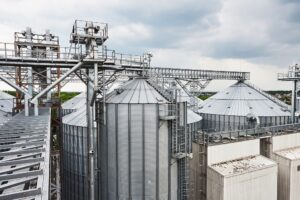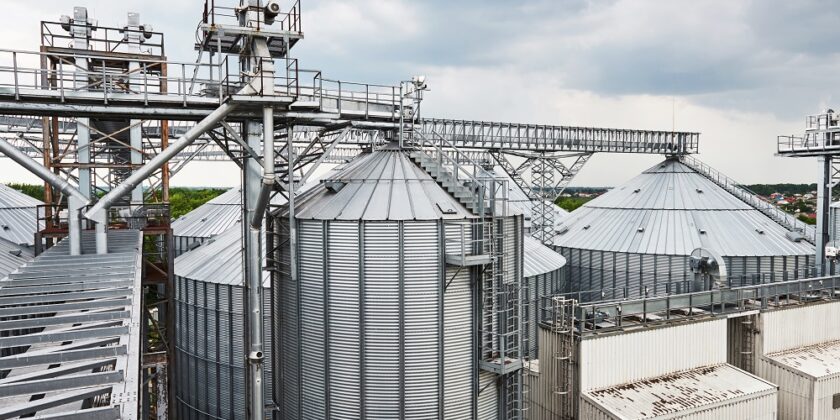The global cement plant industry stands as one of the largest sectors, experiencing a continuous upward growth. Fueled by swift infrastructural development and ongoing technological advancements, the cement industry is thriving at an unprecedented pace.
This crucial sector finds applications across diverse industries, playing a vital role in bolstering the economy. However, the inherent characteristics of the product render it highly susceptible to an array of natural and human-induced factors.

The cement industry is susceptible to various influences, including those stemming from natural elements such as severe weather conditions and calamities. It also faces challenges posed by human-induced factors, such as pollution, vandalism, and theft. Furthermore, the production of cement entails the necessity for substantial storage space to accommodate raw materials like clinkers, limestone and clay.
In the cement industry, the essential requirement for cement plant stems from several critical reasons:
- Storage sheds are imperative to shield cement materials from the impact of diverse weather conditions.
- The presence of storage sheds is crucial to create a barrier against pollutants.
- Storage sheds play a pivotal role in preserving the quality of cement.
- The storage sheds serve as a protective shield, preventing damage that could occur during the storage phase.
Importance of Storage Sheds for Cement Plant
1. For Storing Raw Materials: Storage sheds are instrumental in protecting cement raw materials, such as sand, limestone, clay, and other minerals, from extreme weather elements. Due to the substantial quantities required for cement production, businesses source these materials in bulk. As these raw materials are utilized at different stages of the manufacturing process, storage sheds become indispensable for safe and organized storage, ensuring their availability as needed.
2. For Storing Cement: Once cement is manufactured, it is not always immediately sold in its entirety. Businesses require storage facilities to house the finished product, typically stored in cement bags, protecting it from natural elements. Exposure to rain or sunlight can compromise the quality of the cement over time. Storage sheds provide a sheltered environment, preserving the integrity of the cement and preventing deterioration.
3.For Storage During Transportation: Storage facilities are equally vital during the transportation of both raw materials and finished cement products between the market and the manufacturing plant. Exposure to rain or extreme weather conditions during transit can pose risks to these materials. Storage sheds act as a protective barrier, shielding the materials and ensuring their safety during transportation.
4.For Storage in Off-Season: Temporary storage sheds serve a valuable purpose during off-seasons, such as the construction industry slowdown during monsoons. Given the reduced demand for cement during these periods, businesses can store surplus products safely until construction activity resumes. This strategic use of storage sheds helps manage inventory and ensures that cement remains in optimal condition for future demand.
The Structural Design of Storage Sheds
The storage dome shed, integral to the new dry process cement production line, represents a notable departure from traditional flat storage and silos, owing to its distinctive dome-shaped design. Comprising a concrete silo base and a steel structure roof, this design is characterized by its exceptional versatility. The double-curved shape not only enhances strength but also optimizes vertical storage space, allowing for the efficient accommodation of substantial quantities of cement within a minimized footprint. The dome’s structural integrity extends to its commendable load-bearing capacity that ensures stability during the storage of heavy cement loads. The unloading process is simplified as it is facilitated by a zipper machine in the steel corridor that transports cement from the kiln head to the top of the silo.
Steel pace Frame Structure
The steel space frame structure is selected for the top of the dome storage shed system. The design considerations for the roof space frame align with the specific technological requirements of the storage shed. The roof space frame, shaped like a round table, is strategically positioned on the ring beam of the concrete silo wall at an elevation of approximately 26m.
The chosen configuration for the warehouse’s top features a double-layer favorable quadrangular pyramid structure with bolt ball joints. This structure incorporates 48 supports in its lower section, boasting a center diameter of 60m, an upper platform diameter of 15m, and an overall height of 17.0m with a thickness of 2.0m. To enhance functionality, the upper part of the space frame includes a steel platform constructed from H-shaped steel beams, reaching a top elevation of 44.70m. The support for this steel platform is provided by 16 fulcrums strategically positioned on the roof space frame.
Static Analysis
The static analysis of the selected steel space frame for the clinker dome storage shed indicates high structural performance. The rod section ranges from 75.5×3.75 to a maximum area of 245×16. Total steel consumption is approximately 240t that strengthens the design’s.
Key static analysis findings include a maximum vertical displacement of 44mm at the zipper machine action point, meeting specified standards. The maximum design support reaction forces are 370kN vertically and 130kN radially horizontally. Modal analysis reveals the first 30 vibration modes, ensuring mass participation coefficients exceed 90%. The period and mode shapes of the first three orders highlight the structure’s stiffness and frequency distribution.
The roof space frame’s unique challenges, such as larger vertical and temperature loads, along with equipment vibration considerations, underscore the complexity of the design. Despite these challenges, the steel space frame remains critical for meeting the stringent requirements of the dome storage shed.
Conclusion
The design of clinker storage sheds plays a pivotal role in ensuring the production of high-quality cement. A well-thought-out design not only protects the cement but also increases overall operational efficiency. The longevity and reliability of storage sheds as a solution for cement production are contingent on the consideration of these design factors.
Our shed solutions provide expansive, unobstructed, and column-free spaces suitable for various purposes, including the storage of finished goods, raw materials, and heavy or mobile machinery. All our products are crafted in a cutting-edge, in-house manufacturing facility, ensuring precision and excellence in every aspect. With years of industrial expertise spanning various sectors, we possess a deep understanding of diverse business requirements that allow us to customize our products accordingly.
If your business demands high-quality storage solutions, Alcox Hindustan Limited is your reliable partner. Feel free to reach out to us promptly to explore how our expertise can contribute to meeting your storage needs.


